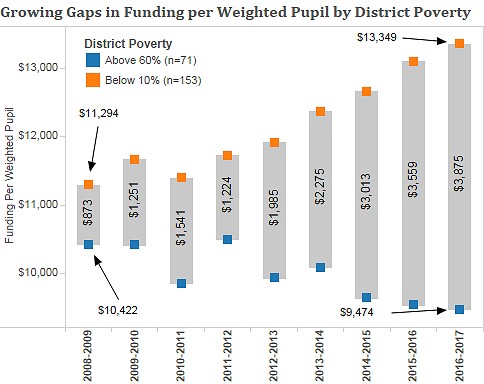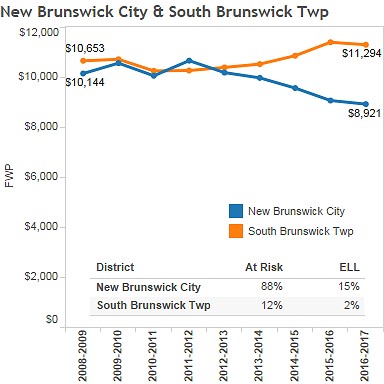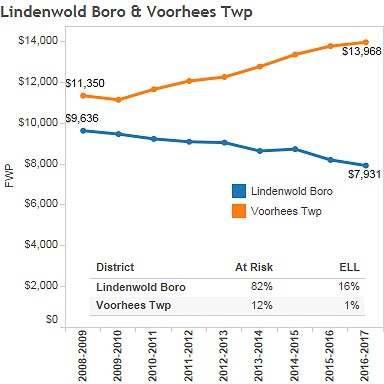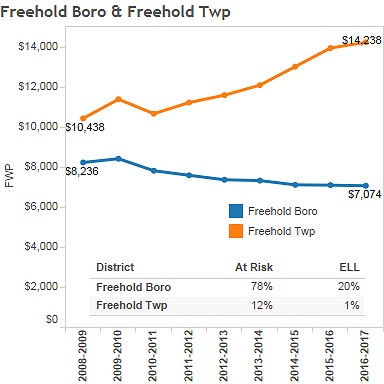FUNDING GAPS WIDEN BETWEEN NEW JERSEY’S LOW AND HIGH POVERTY SCHOOLS
Under Governor Chris Christie, funding gaps between school districts with the highest and lowest student poverty rates continue to grow, increasing four-fold to a staggering $3,875 per pupil since 2008-09. This widening gap is caused by two factors: growth in the population of poor or “at-risk” students and the Governor’s refusal to fund the aid increases required for those students under the School Funding Reform Act (SFRA), New Jersey’s weighted student funding formula.
These findings are from an Education Law Center analysis comparing district funding levels using each district’s unique “weighted student enrollment” under the SFRA formula. This analysis captures the central element of the SFRA: providing each district with the additional resources and funding necessary to give at-risk and English language learner (ELL) students a meaningful opportunity to meet New Jersey’s academic standards.
By using the SFRA’s weighted enrollments, ELC calculates the level of funding in each district adjusted for student need based on poverty, ELL, and disability status and according to the formula. This method is called “weighted funding per pupil” and offers a more accurate comparison of how much state and local funding school districts across the state receive to educate students, accounting for each district’s unique demographics.
ELC’s weighted funding per pupil analysis shows:
- From 2008-09 to 2016-17, the number of at-risk (poor) students has increased by 40% from about 364,000 to over 511,000.
- During the same period, the number of districts with student poverty over 40% has almost doubled from 79 to 151. Districts with 40% or more student poverty are defined by the NJ Department of Education (DOE) as “high need” and are subject to class size limits and other program mandates.
- The weighted per pupil funding gap between the highest and lowest poverty districts has risen from $873 per pupil in 2008-09, to $3,875 per pupil in the current school year. While the lowest poverty districts received only 8% more funding than the highest in 2008-09, they now receive 40% more.

To illustrate these funding gaps, ELC compared weighted funding per pupil between sets of neighboring districts across the state:

In New Brunswick, nearly 90% of the students are at-risk and 15% are ELL. South Brunswick enrolls 12% at-risk and 2% ELL. From 2008-09 through 2012-13, both districts were funded at a comparable amount per weighted pupil. However, the growth in at-risk students coupled with chronic underfunding in New Brunswick has widened the gap between the districts. New Brunswick is funded at $2,373 less per weighted pupil than South Brunswick in 2016-17.

Bound Brook’s student population is 77% at-risk and 14% ELL, while nearby Hillsborough is 9% at-risk and 2% ELL. Bound Brook’s funding per weighted pupil has declined from $9,149 to $7,457 since 2008-09. The weighted funding gap between Bound Brook and Hillsborough is over $4,400 per pupil in 2016-17.

Lindenwold has a growing population of at-risk students: 82% in the current school year. And the ELL population is at 16%. Voorhees has 12% at-risk and 1% ELL. The gap in funding per weighted pupil between Lindenwold and Voorhees grew from $1,714 in 2008-09, to over $6,000 in 2016-17.

Freehold Borough has experienced significant growth in the number of at-risk students and ELLs, serving 78% and 20%, respectively. In Freehold Township, the student population is 12% at-risk and 1% ELL. The funding gap between the districts has grown from about $2,200 in 2008-09, to over $7,000 per pupil in 2016-17.
“These findings are extremely disheartening,” said David Sciarra, ELC Executive Director. “By providing additional resources to our neediest students, the SFRA was designed to shrink funding gaps between low and high poverty school districts. By starving schools of the aid increases required by the formula, those gaps have grown, reversing a decade of progress from 1999 to 2009.”
ELC has also issued a five-point plan to begin to address funding shortfalls in high poverty districts in the FY18 State Budget now under consideration by the Legislature. It is crucial that lawmakers take action to put the SFRA back on course to reach the goal of equitable and fair funding the formula is intended to achieve.
Related Stories:
GOVERNOR CHRISTIE’S EDUCATION LEGACY: STARVE SCHOOLS, ABANDON STUDENTS
5 STEPS TO IMPROVE THE FY18 STATE BUDGET FOR NJ SCHOOL CHILDREN
Press Contact:
Sharon Krengel
Policy and Outreach Director
skrengel@edlawcenter.org
973-624-1815, x 24
Press Contact:
Sharon Krengel
Director of Policy, Strategic Partnerships and Communications
skrengel@edlawcenter.org
973-624-1815, x240